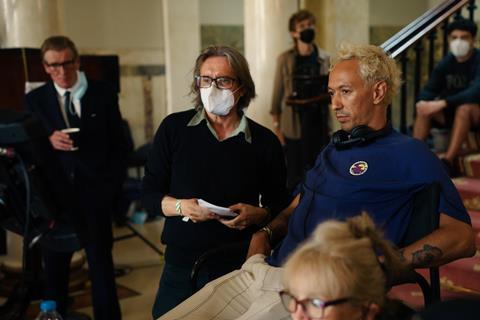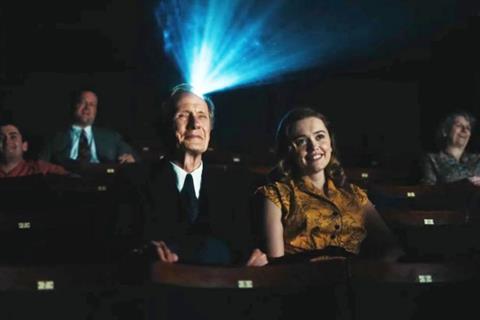In converting Japanese film Ikiru to UK drama Living, director Oliver Hermanus, screenwriter Kazuo Ishiguro and producer Stephen Woolley were able to add a note of positivity and optimism — as they explain to Screen.

When South African filmmaker Oliver Hermanus met Stephen Woolley for a general meeting at the October 2019 BFI London Film Festival, where he was showing Moffie, he little imagined that within a few short months he would be attached to direct a feature for the UK producer.
Hermanus returned to South Africa, but was back in London in December for the British Independent Film Awards, where Moffie had several nominations including best director. By that time, Woolley had been in touch to discuss Living — a remake of Akira Kurosawa’s 1952 film Ikiru, adapted by Kazuo Ishiguro, and transposed to 1950s London and south England. Hermanus met Ishiguro in London, as well as Film4, which was financing development of the film.
“It was all very fast,” he recalls. “It felt like I read the script, I talked about it with Steve and came in for a few meetings, and then, by the next time I came back, it had already been approved that I would be part of the film.”
The genesis of Living began a couple of years earlier, when Woolley was programming a season of films at London’s BFI Southbank — titled ‘Girls Like Us: British women in WWII cinema’ — to accompany the UK release of his production Their Finest. He and his wife Elizabeth Karlsen, who run Number 9 Films, attended a party where Woolley met a random stranger — or so he thought — who shared his passion for 1940s UK cinema. It was only on the way home that Karlsen asked what on earth he had been talking about to Nobel Prize-winning novelist Kazuo Ishiguro for two hours.
Woolley and Karlsen invited Ishiguro and his wife Lorna MacDougall for dinner at their London flat to continue the conversation, where they were later joined by actor Bill Nighy. And after a mix-up that had stranded Nighy’s return taxi in the wrong location, a shared ride home allowed the writer to pitch what he said could be a great role: the buttoned-up civil servant who discovers a new lease of life after receiving a terminal-illness diagnosis.
“To which my wife said, ‘Leave Bill alone, he’s got plenty of work, stop bothering him and just shut up,’” recalls Ishiguro. “It wasn’t just a remake of Ikiru. The whole concept was, it’ll be a remake with Bill, because the way I saw it, it was going to be just as much about Englishness, the concept of the English gentleman, and all that implies about emotional reticence and how you face bad things in life, how you face emotions. I could see Bill being the way into that whole theme.
“But I have to emphasise, I wasn’t suggesting I wrote the screenplay. I’m not a screenwriter. I don’t usually do that. I have this awful habit of saying to filmmaker friends, ‘Here’s a fantastic idea, please go and make it’.”
Ishiguro was also motivated by the idea Nighy would be — whisper it — an improvement on Kurosawa’s original actor Takashi Shimura. Although the screenwriter greatly esteems Shimura for his work in Kurosawa films such as Seven Samurai and Stray Dog, he always thought Chishu Ryu — best known for a string of textured roles in films by Yasujiro Ozu including Tokyo Story — would have been a better fit for Ikiru.
“It struck me that we have a version of Chishu Ryu right now in Britain, and that is Bill Nighy, with that mixture of irony, self-deprecating humour, stoicism and a happy resignation to the essential sadness of life,” Ishiguro adds. “I mean, these are the things Ryu conveyed miraculously, and I thought Bill could do it. Even the name Williams, I derived it from Bill’s first name. We would have been in real trouble if Bill hadn’t wanted to do it.”
Woolley agreed the idea was worth pursuing, but contradicted the author’s claim that he is not a screenwriter — in fact Ishiguro’s screenwriting credits began with a pair of single dramas he wrote for Channel 4, airing in 1984, and he has followed up with screenplays written “just for fun”, which nobody has seen. “Stephen said, ‘Since it’s your idea, you should at least have a go. And then if it’s awful, as you claim it’s going to be, I’ll try somebody else.’”
In order to launch the project into development, Number 9 first needed to secure the English-language remake rights to Ikiru — which meant dealing with Japan’s Toho and the Kurosawa estate. The problem was, explains Woolley, “They had been approached years earlier by Steven Spielberg to do a version with Tom Hanks, and of course they’d been paid loads of money.” That option fee had established the bar for the value of the rights, which were not affordable for a UK independent film potentially backed by Film4 and Lionsgate.
The Kurosawa estate suddenly became more amenable after the producer mentioned the name of his screenwriter — but they needed proof, and a signed letter from Ishiguro turned out not to be sufficient. “So Ish did a film in his kitchen, saying, ‘Hello, I am Ishiguro. I’m planning to write the script for Stephen Woolley of this project.’ It’s a very funny, three or four-minute short.”
Initially, Number 9 attached a US director “who will be nameless”, says Woolley. “A very big American director, and he was making a huge television thing at the time. We were meeting with him in London and communicating with him, but it was constantly, ‘Oh, let’s keep talking.’ I only had a two-year option, my time was running out and I realised we’re never going to make it with that person.”
Adds Ishiguro: “Stephen and I always said that, by and large, we should look at non-British directors. We wanted an outsider’s view of this period Britain.” Enter Oliver Hermanus. Film4 “embraced the idea”, says Woolley, and soon the director was collaborating with Ishiguro on further drafts of the screenplay.

Pause button
Number 9 was eyeing a summer 2020 shoot for two of its productions — with Karlsen leading on Mothering Sunday, directed by Eva Husson, and Woolley leading on Living. Despite the arrival of the pandemic in the UK in March, Karlsen was able to proceed that summer with her film — a contained drama largely consisting of scenes with Odessa Young and Josh O’Connor in a single location.
Living was a different story. It features scenes set in the busy offices of London County Council, where Nighy’s character (always referred to by his surname) works; on commuter trains; in bars and cafes and on the streets of London; and in a south coast seaside town, modelled on Brighton.
“There’s tons of extras milling around,” explains Woolley. “We could never have done that in that summer when we did Mothering Sunday.” Instead, Hermanus and Ishiguro were able to extend the collaboration on the screenplay.
“When I started to work with Oliver, I suppose it’s one of the few compensations of the pandemic that we were all stalled in whatever we were doing,” says Ishiguro. “Oliver and I, and Steve, we spent hours when we were locked down in our respective houses, on Zoom, talking about different aspects of the screenplay, about how we’d do the film. Oliver is almost obsessive about scrutinising every detail. And the screenplay, I think, got better and better.”
While the screenwriter and director extended their collaboration, Woolley followed an introduction that had been made by his former producer partner Nik Powell — to County Hall Arts. Powell knew a key trustee was a fan of both Ishiguro the writer and Ikiru the film.
County Hall not only provided vital locations for the film — two floors of offices that had remained untouched for decades — but County Hall Arts also invested in the production. Powell, who died in 2019, and his Scala partner Ian Prior were both awarded executive producer credits.

Talent discoveries
When it came to casting, Number 9 brought in Kahleen Crawford as casting director, who is best known for her work on multiple Ken Loach films. “It was a movie driven by the same pressures as any other film,” says Hermanus, meaning that they were seeking the best actors for the roles that would also “satisfy the investors”.
Crawford proved a key ally when making those choices. “I don’t think that executives on Living were against us, I think that the job is to always try and get the biggest names possible,” explains Hermanus. “Kahleen really championed the choices that I wanted to make and the people I wanted to work with.”
Aimee Lou Wood (Sex Education) was cast in the pivotal role of Margaret, who forms a bond with Williams after his diagnosis, and inspires him to find true meaning with productive work in his final months of life. Alex Sharp (The Trial Of The Chicago 7) plays the ingenuous new County Council team member Peter who pursues Margaret romantically — a storyline introduced by Hermanus and Ishiguro that is not in Ikiru. Tom Burke plays Sutherland, a hedonistic — but nevertheless sympathetic — character who leads Williams on a wild night in a seaside resort.
“Aimee Lou Wood was somebody Kahleen and I just instantly knew we had to have, and it was about getting that over the line [with the executives],” says Hermanus. “The same with Tom Burke and Alex Sharp. Every person we passed around that desk was somebody Kahleen had an instinct about and knew I would connect with.”
Cameras rolled on a 38-day shoot in summer 2021 in London and the south of England. With productions having been held up for a year by the pandemic, Living faced intense competition from well-resourced TV and streamer productions for locations, crew and support staff — meaning the budget was stretched thin.
“It was hard for the crew and it was hard for Oliver,” says Woolley, who produced Living alongside Karlsen. “But he managed to create an atmosphere for the actors that they didn’t seem to notice. They enjoyed the experience so much that they didn’t seem to care we had four different caterers, and the food was horrible. Whereas for us, we were trying so hard to make the experience the best it can be, but failing dismally, most of the time.”
Any shortcomings in comfort were placed in their proper context when Living was selected for Sundance Film Festival in January — and then also Venice, Telluride, Toronto and BFI London. Lionsgate opened the film in UK and Ireland cinemas in early November, grossing a healthy $4m (£3.3m) at press time. Sony Pictures Classics will follow in North America on December 23.
Living was rewarded with nine nominations at the British Independent Film Awards, winning only for Helen Scott’s production design. The film may have better luck connecting with the tastes of voters in the Bafta Film Awards, and also the Oscars where Nighy may prove a contender. Helping it connect with audiences — and maybe voters — is the film’s positive, finally uplifting tone.
“When Kurosawa and [his co-writers] wrote their script, they didn’t know that Japan was going to recover from the war, turn into this economic superpower within a few years and become one of the most solid liberal democracies in the world, having been this rather nasty fascist, military power,” explains Ishiguro. “Their film is quite pessimistic about the ability of things to improve, of the civil service being able to achieve anything.”
With Living, on the other hand, Ishiguro continues, “we had the benefit of hindsight. Whatever criticisms we might have about our society, I still think that was one of the great achievements [of the UK] — to build this fairer society after the Second World War, with a welfare state, the National Health Service and state education.
“I thought our film could have optimism, and there should be a greater sense that with Williams’ example, there will be a legacy with a younger generation who would receive it and do something with it.”






![The Brightest SunScreen[Courtesy HKIFF]](https://d1nslcd7m2225b.cloudfront.net/Pictures/274x183/3/5/0/1448350_thebrightestsunscreencourtesyhkiff_312678.jpg)


















No comments yet